During my time treating patients with a wide variety of problems there is one theme which seems to come up consistently. Regardless of the problem one of the main things I check on every patients first visit is their leg length.
Have you ever noticed when it rains one trouser seems to a little wet at the bottom while the other is dry, well you are not alone and it is a really common occurrence. It is very rare to be born with one leg shorter than the other yet is remarkably common for one leg to be more tense than the other. This can happen for a number of reasons ranging from maybe a serious injury to the leg previously or something really innocuous, like one patient who is a teacher and always leans on the same leg when teaching class and cumulative effect over a number of years led to one leg being shorter than the other simply through muscle tightness.
As you may be able to imagine if one leg is shorter than the other this can have a profound effect on the rest of the body. It can effect the knees by putting extra pressure on one knee. The pelvis has to compensate as does the spine and consequently working its way up to the neck even leading to headaches. In some cases this may not be the main cause of the problem but by having this corrected at any time can prevent problems down the line.
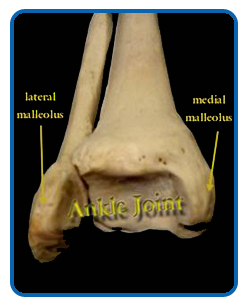
The procedure only takes around twenty minutes and can help prevent many problems in the future. It is possible to do a quick check on your partner or friend by just lying them down on their back and gently pulling their legs.
It should be immediately clear if the legs are the same or not. The easiest way to check is to see if each malleolus (the bony prominence on either side of the ankle) are in line.
This picture shows you exactly the area which you need check.
It’s the medial ones (the ones on the inside of the leg) that are the easiest to compare. The next picture will illustrate what the legs typically look like when they are not the same length.
Unequal Leg Length
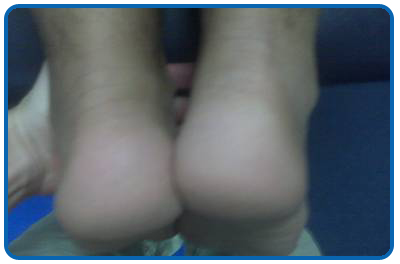
Leg Length Post Massage
Here you can clearly see without looking at the malleoli that there is a clear difference in the patients leg length.
As long as the difference is no more than 1cm then this more than likely simply down to muscle tension. In the picture above it is clear that his right leg is shorter than his left. After the initial history taking I suspected that after an old injury that he would have one leg shorter than the other. After the treatment which only lasts around 20-25 minutes you will be able to clearly see the difference in the patients leg length.
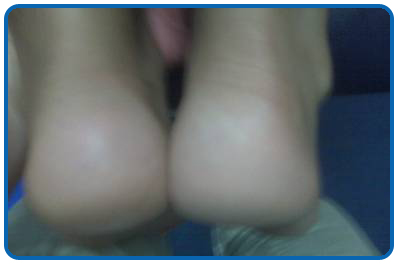
In the main the problems are in 3 main places.
1. The Gacilis Muscle
The Gracilis muscle has its origin on the lower margin of the pubic bone and attaches onto the tibia on the inside of the leg just below the knee(see picture).

The main function of this muscle is to take the bring the hip joint towards the body (adduction) , it also aids with the flexion of the knee and turn the knee towards the body (medial rotation) when the knee is flexed
As you can see this muscle is in contact and has an influence on two major joints. If this muscle is chronically tight or fatigued then it can have an impact on either or both joints.
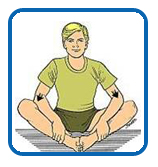
When it is chronically tight it can often lead to groin pulls (which are more common in men than women as they tend to be tighter in men anyway).This muscle is relatively easy to isolate during a stretch and I personally suggest the stretch shown in the picture left but there are several others and in the end comes down to personal preference.
This muscle responds very well to certain Remedial Massage techniques.
2. The Hamstring Muscles
The Hamstring muscles (which comprise of three separate muscles) are the more well known of three common problem areas.
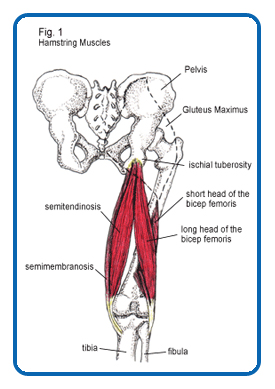
All three muscles have their main origin on the Ischial Tuberosity (sitting bone) , they then all attach below the knee so making them a major flexor of the knee which is there primary function, to control knee flexion.
They also help extend the hip backwards. Tightness in the Hamstring can lead to lower back pain, knee pain, and leg length discrepancies.
These group of muscles also respond well to Remedial Massage techniques and in one session a persons flexibility can be increased by up to 10%.
3. ITB (iliotibial) Band
The third is the ITB (iliotibial) band. This is the hardest and the most common cause of leg length discrepancies.
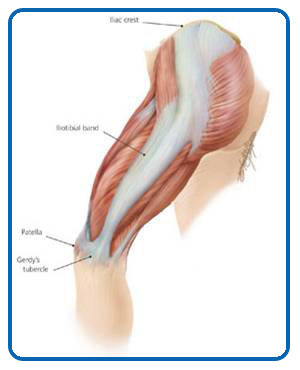
The ITB band is predominately fascia rather muscle so self stretches are very difficult. As it originates from outer iliac crest (where it is part of the TFL (Tensor Fasciae Latae muscle) and attaches to the outside of the knee at the top of the tibia it is an extremely crucial muscle and fascia.
It flexes and abducts (takes the hip away from the body) the hip and stabilises the knee so any hyper tension in this muscle can lead to pelvic imbalances , which can cause hip pains and then lead to lower back problems.
In conjunction with work on the Tensor fascia late and the Gluteus muscles this muscle can be elongated by a significant amount in one session and when done in combination with the above muscles it can help lengthen one leg as is shown in the earlier pictures.
All three of these can be returned back to their original state in a short session and in certain cases will can even be source of the several problems. In other cases it may not be sole reason for the pain but it will certainly benefit any individual in the long run to make sure their leg length is same. In a lot cases I like to correct this in the first session, then leave it a week or so if the patient is not in too much pain so I can see what effect this alteration has on the body.
If you think that you have a leg length differential then give me a call and I will happily put you on an equal footing.
